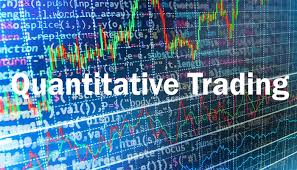
In the fast-paced world of modern finance, technology and mathematics have reshaped the way markets operate. Traditional trading methods, once dominated by intuition and human judgment, have increasingly given way to algorithms, statistical models, and automation. At the heart of this transformation lies quantitative trading, commonly known as quant trading.
Quant trading leverages mathematical models, computer algorithms, and vast amounts of data to identify trading opportunities and execute transactions at speeds and scales that humans cannot match. From hedge funds to investment banks and even individual traders, quantitative strategies now play a central role in global financial markets.
This article dives deep into what quant trading is, how it works, its advantages and challenges, and why it represents the future of investing.
What is Quantitative Trading?
Quantitative trading is a form of investment strategy that relies on quantitative analysis—using mathematical and statistical models to make trading decisions. Instead of relying on gut feelings or market rumors, quant traders use data-driven approaches to identify patterns, predict price movements, and execute trades.
The essence of quant trading is simple:
-
Collect massive amounts of financial and market data.
-
Use algorithms and models to analyze the data.
-
Identify trading opportunities with statistical significance.
-
Automate execution to minimize human error and emotion.
This method is especially popular in high-frequency trading (HFT), hedge funds, and institutional investing, where precision and speed make the difference between profit and loss.
The Rise of Quant Trading
While quant trading feels like a recent trend, its roots go back several decades. In the 1970s, Wall Street began experimenting with statistical arbitrage, options pricing, and computer-assisted trading. The famous Black-Scholes model, developed in 1973, provided a mathematical way to price options and became a foundation for early quant strategies.
By the 1990s and 2000s, advances in computing power and internet connectivity allowed hedge funds like Renaissance Technologies, DE Shaw, and Two Sigma to dominate markets using sophisticated algorithms. These firms achieved remarkable returns by exploiting inefficiencies that human traders couldn’t detect.
Today, quant trading is no longer exclusive to billion-dollar hedge funds. Cloud computing, open-source libraries (like Python’s Pandas and NumPy), and access to big data have made it possible for smaller funds and even retail traders to explore algorithmic strategies.
How Quant Trading Works
At its core, quant trading involves several key components:
1. Data Collection
Data is the lifeblood of quant trading. Traders use a wide range of datasets, including:
-
Market data (prices, volumes, order books)
-
Fundamental data (earnings reports, balance sheets)
-
Alternative data (social media sentiment, satellite imagery, credit card transactions)
2. Strategy Development
Quantitative analysts, often called “quants,” design models based on mathematical and statistical principles. Some popular strategies include:
-
Statistical Arbitrage: Exploiting pricing inefficiencies between related assets.
-
Trend Following: Identifying upward or downward momentum in prices.
-
Mean Reversion: Assuming prices will revert to historical averages.
-
Machine Learning Models: Using AI to detect complex patterns in data.
3. Backtesting
Before deploying a strategy in real markets, quants test it using historical data. Backtesting ensures that the model works in different market conditions and helps measure potential risk and return.
4. Execution
Once a strategy is approved, it is automated using algorithms. This ensures trades are executed at the optimal price and speed, often in milliseconds.
5. Risk Management
Since no model is perfect, quant trading heavily emphasizes risk controls. Techniques include position sizing, stop-loss orders, diversification, and scenario analysis.
Advantages of Quantitative Trading
Quant trading offers several key benefits over traditional methods:
1. Data-Driven Decisions
Unlike discretionary trading, quant strategies remove human bias and emotion. Decisions are based strictly on numbers and probabilities.
2. Speed and Efficiency
Algorithms can process information and execute trades far faster than humans. This is especially critical in high-frequency trading, where milliseconds matter.
3. Scalability
A single algorithm can analyze and trade hundreds of assets simultaneously, something impossible for a human trader.
4. Consistency
Quant strategies follow rules without deviation, ensuring consistency across different market conditions.
5. Access to Alternative Data
With big data and machine learning, quants can uncover hidden signals from unconventional sources, giving them an edge.
Challenges and Risks of Quant Trading
Despite its advantages, quant trading is not without risks:
1. Model Risk
Models are only as good as the assumptions they’re built on. If the market behaves unexpectedly, a strategy can fail.
2. Overfitting
Backtesting can lead to overfitted models that perform well on historical data but fail in real-time trading.
3. Technology Failures
Since algorithms operate at high speed, a technical glitch can cause massive losses in seconds.
4. Market Saturation
As more traders use similar models, profits can shrink. Opportunities that once generated large returns may no longer exist.
5. Regulatory Scrutiny
High-frequency trading and algorithmic strategies often face criticism for contributing to market volatility, leading to tighter regulations.
Popular Quantitative Trading Strategies
To better understand quant trading, let’s look at some widely used strategies:
-
Pairs Trading (Statistical Arbitrage): Traders identify two historically correlated stocks. If their prices diverge, they short the outperforming stock and buy the underperforming one, betting they’ll converge again.
-
Momentum Trading: Algorithms detect strong upward or downward trends and ride the momentum until signs of reversal.
-
Market Making: Providing liquidity by continuously buying and selling securities, profiting from the bid-ask spread.
-
Machine Learning Models: Using techniques like neural networks to predict price movements based on vast datasets.
These strategies often combine multiple methods for better risk-adjusted returns.
Quant Trading in Hedge Funds and Institutions
Some of the most successful hedge funds in history are quant-driven:
-
Renaissance Technologies: Known for its Medallion Fund, which reportedly generated returns of over 60% annually before fees.
-
Two Sigma: Uses machine learning and big data to manage billions of dollars in assets.
-
Citadel Securities: A major market maker using algorithmic trading strategies.
These firms invest heavily in talent, hiring mathematicians, physicists, and computer scientists to design cutting-edge models.
The Role of Technology in Quant Trading
Quant trading thrives on technology. Some essential tools include:
-
Programming Languages: Python, R, C++, and Java are widely used.
-
Databases and APIs: For real-time data access and management.
-
Cloud Computing: Allows scalability and faster computation.
-
Machine Learning Frameworks: TensorFlow, PyTorch, and Scikit-learn for building predictive models.
As technology advances, quant trading strategies continue to evolve, incorporating artificial intelligence, deep learning, and natural language processing.
The Future of Quant Trading
Looking ahead, quant trading is expected to become even more dominant. Key trends include:
-
AI and Deep Learning: Advanced models will uncover patterns too complex for traditional statistics.
-
Alternative Data Expansion: Sources like satellite imagery, weather patterns, and social media will play a larger role.
-
Retail Quant Trading: More platforms and tools will empower individual traders to use quant strategies once reserved for institutions.
-
Regulation: Governments will continue monitoring algorithmic trading to reduce risks of flash crashes and systemic instability.
-
Sustainability and ESG Integration: Quants may use data to build models that focus on environmental, social, and governance (ESG) factors.
Conclusion
Quantitative trading has revolutionized the financial industry by replacing intuition-driven decisions with data, mathematics, and algorithms. From hedge funds earning billions to individual traders experimenting with Python scripts, quant trading has democratized access to powerful strategies that once seemed out of reach.
While challenges like model risk and regulatory scrutiny remain, the future of quant trading is bright. As technology advances and data becomes more abundant, quantitative methods will only grow more sophisticated and widespread.
Ultimately, quant trading represents the evolution of markets—where science meets finance, and where speed, precision, and data shape the future of investing.

